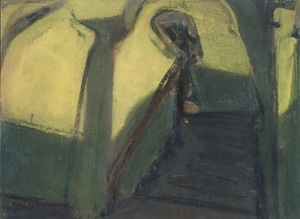IN MEMORIAM OF A.VAITKŪNAS. STAIRCASES. 0
Aušra Barzdukaitė-Vaitkūnienė
www.kamane.lt 2008 05 12
“Principal Staircase“, 1984, canvas, oil. 70x85 cm
In brief: “I remember coming back to Kaunas and thinking – what should I do now that I graduated from the institute? I could not see the world. Everything was closed. It seemed there was nobody to speak to. Perhaps it was due to loneliness that I found some shabby staircase and felt that it was talking to me. It was interesting to hear what it told. One only had to put down this tale“, remembered Arūnas about his first years in Kaunas after the studies.
“It was the time of the old town restoration when residents were moved out, and concrete, wooden staircases, old doors still remained marked with old information. Later they destroyed everything. They constructed concrete staircases, iron handrails, plywood doors. It was a kind of genocide – erasure of the memory layer. I used to stand and paint staircases talking with them – it seemed that they wanted to give information to me.
I used to go there in the early morning. It was suitable for me as an artist. (…) The staircases seemed like a symbol of situation of that time: closed existence, in which you may climb up or down. Small gaps of windows in walls through which you see a different life.
(…) One night I appeared in a poorly looking staircase of an old house. I felt that the air of that staircase, the environment wanted to tell me something that there was something important in it. I brought paint and some canvas and painted the staircase until the morning. This was how a cycle of old things, interiors, closed space and the theme of staircases was born. I painted in nature, usually at night. At daytime the staircases were usually “distracted” and did not want to speak.” (A.Vaitkūnas told about it in 1995-96. – A.B.-V.)
“It is easier to concentrate when dusk comes. All unimportant things disappear at night, the essence remains, let us say, of some cloth. Or perhaps it is my concentration at night, or the merit of that thing, or the effect of dusk? I did not analyse this. It was enough to paint a work for me“. (From stories of 1993. – A.B.-V.)
“I remember people asking me why I was painting those staircases. There was no external beauty. Perhaps they were really not needed by anybody. I did not even think of somebody buying these paintings. Still, after several years people came telling me that it was a good idea and asking to sell them. I would sell them but I do not paint such paintings any more. It is past time already. It is not difficult to repeat oneself but why should I do it. I work naturally how I feel at that time.
...I hate “making” in art specifically. The making of a painting, sculpture, idea, etc. A painting, like a tree, has to grow naturally. If a tree does not grow, it is not its fault – it is the soil, the place it is growing in. To put it short, one needs to prepare the soil“. (A thought put down on November 13, 1988. – A.B.-V.)
Painting at midnight with a tiny lamp or a candle brought by Arūnas. It is painting that requires incredible spiritual and physical tension. He had to hear and transfer the sighs and whispers of forlorn staircases, to capture and embody delirium of feverish conscience that remained between the broken stairs. Such was the decision of Arūnas – to balance on the border which may be believed in already, according to him, as it left unique paintings to us.

